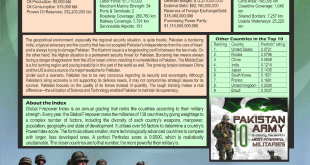By: Ali Sarfraz
The subject of International Relations (IR) deals with the interactions among specific actors which include nation-states, international organizations and multinational corporations. These interactions involve interdependent, goal-directed activities. Interdependency means that the achievement of the goals of any nation-state does not depend only upon its own actions, but also upon those of the other nation-states. In the domain of IR, this is called the Game Theory which explains the behaviour of decision-makers in situations of strategic interdependence.
Introduction
Game theory, also known as interactive decision theory, is based on an abstract form of reasoning arising from a combination of mathematics and logic. As a branch of pure mathematics, the theory of games sets forth postulates from which mathematical conclusions are derived. Nearly all game theorists agree that the theory with which they deal is addressed to what is rationally correct behaviour in situations in which actors engage in interaction in the form of a game with specific strategies, goals and preferred outcomes. Here the actors are trying to win or maximize gain or minimize loss. For centuries, kings and military officers have played war games (not actual wars) as a practice of strategies. Game theory, in modern times, is also applied to other social sciences, not only in psychology and economics. Its founders are John Von Neumann and Oskar Morgenstern who published the book The Theory of Games and Economic Behavior in 1944.
Definition
Game theory is generally defined as a body of thought dealing with rational decision strategies in situations of conflict and competition, wherein each participant or player seeks to maximise his gains and minimise losses.
Oxford Concise Dictionary of Politics defines game theory in the following words:
“A game is any situation in which the outcomes (pay offs) are the product of the interaction of more than one rational player. The term, therefore, includes not only games in the ordinary sense, such as chess and football, but an enormously wide range of human interactions.”
Scope in IR
Game theory provides a number of advantages for the analysis of international relations. It requires that a conflict situation or decision process be examined from the point of the utilities and disadvantages that alternative courses of action are offered to each participant. Since it postulates a setting in which both sides make rational calculation of their own self-interest, game theory offers the opportunity of viewing one’s antagonist as something other than an incompetent swine or omniscient superman.
Because game theory can offer the opportunity for quantitative procedures and for the systematic treatment and comparison of otherwise diverse situations, advocates of game theory have tended to argue that if a problem is genuinely understood it can also be represented by a mathematical model. But its opponents have countered by saying that such reduction of a problem results in oversimplification and sterility. Here are elements of truth in both arguments.
Exponents
The game theory takes inspiration from the model of parlour games of conflict and cooperation, and, by analogy, applies these to similar real-life situation in the world. The theory was primarily propounded by mathematicians and economists. Neumann and Morgenstern developed this theory in the sphere of economics. Later, it was applied to many fields of social science including international relations with modifications. Shubik, Schelling, Rapoport, Deutsch, Riker et al., take recourse to this theory for explaining international politics.
Read More: Monetization of International Relations
Assumptions
Game theory is mathematical and deductive in form and tenor. It relies on some axioms and assumptions. Conflict situations are treated as games, and strategies are chosen logically using these axioms and assumptions. Gaming offers a way for laboratory testing of real life situations. Solutions are derived from deductive reasoning. The game theory also assumes the following elements; without them no game can be played.
1. Strategy
The core concept of game theory is strategy. It implies a skilful plan of the previously decided set of moves to be taken as and when the expected moves of the other side require them. The strategy takes into account the potential behaviour of opponents and assumes that within limits of particular situations, the range of strategy is not unlimited. The rational behaviour is that which aims at the selection of a strategy by each player that will maximize the chances of victory. A strategy that is pure takes care of all contingencies under a single instruction. However, whether it is pure or mixed, the aim of the strategist is to maximize his own payoffs while keeping in mind the fact that he must act in the presence of other players with conflicting or, at least, divergent interest whose choices will partially determine the outcome and pay off of the game.
2. Information
The amount of information available and the mode of signalling would significantly influence the strategies of rival players. In strategic games, the players work out signals to communicate to each other; both to encourage friends and to mislead opponents.
3. Purpose
The purpose of the game theory is to first formulate principles which could specify what can be a rational behaviour in certain social situations; and second, to formulate on the basis of those principles the general characteristics of that behaviour. The theory develops mathematical formulations about choice – making among alternative courses of action when it is impossible to control all the factors which govern the outcome because of the actions of others.
Shubik explains following purposes of the gaming:
a. Operational games are designed for cross-chocking other techniques employed for the task;
b. These are intended to furnish further planning, exploration and testing of the specific operations.
c. These elicit group opinion and judgement on specific policy matters;
d. ‘Brainstorming’ for forecasting and other operational applications;
e. Advocacy uses of games.
Involved Kinds of Games
There are different kinds of games on the basis of the number of players involved and pay-off structures. Game of two players is called zero-sum game whereas game of more than two players is known as n-person game. Then, there are variable-sum games or non-zero-sum games or mixed-motive games. The variable-sum games are further divided into two sub categories: game of ‘chicken’ and ‘prisoner’s dilemma’.
Zero-sum Games
 When the total of the ‘pay-off’ is fixed, we call it the zero-sum game. In such a situation, the gain of one player must be at the cost of the other. These are the so-called ‘fixed-sum games’. If all the gains and losses are equal, we speak about a ‘zero-sum-game’. In the situation of stark conflict, rationality obtains as each player can calculate his probable gains and losses and find out the most rational strategy which he can adopt on the basis of calculating their chances. Each player aims at the highest possible gain at the cost of the highest possible loss of the opponent but will accept the smallest possible gain if he knows that this is likely to be the most that he can obtain. If the two players rationally choose the worst of the best and the best of the worst respectively, a stable solution called a ‘saddle point’ is occasionally found.
When the total of the ‘pay-off’ is fixed, we call it the zero-sum game. In such a situation, the gain of one player must be at the cost of the other. These are the so-called ‘fixed-sum games’. If all the gains and losses are equal, we speak about a ‘zero-sum-game’. In the situation of stark conflict, rationality obtains as each player can calculate his probable gains and losses and find out the most rational strategy which he can adopt on the basis of calculating their chances. Each player aims at the highest possible gain at the cost of the highest possible loss of the opponent but will accept the smallest possible gain if he knows that this is likely to be the most that he can obtain. If the two players rationally choose the worst of the best and the best of the worst respectively, a stable solution called a ‘saddle point’ is occasionally found.
When the number of players increases, the strategy becomes that of n-person zero-sum-games. In this game, it is not feasible to calculate the results of the game on the basis of a clear loss and gain to any particular player. Whenever there is an increase in the number of players, a new situation develops. This situation is characterized by the form of coalitions and the emergence of ties between those coalitions. In this type of game, there is often a tendency among the participants to extract maximum gain by forming coalitions. In international politics, William Riker’s n-person zero-sum games’ model can structure much of UN diplomacy; for instance, when a state seeks support for its national position or the problem arises of including states under undesirable regimes in an alliance which means paying the cost, as shown in the attitude of NATO to the Colonel’s regime in Greece to Franço’s Spain.
Variable-sum Games
Two basic types of the variable-sum games are fundamental.
a. Chicken Game
The first is the game of mutual threats graced with the name ‘chicken’. Its paradigm is the situation in which two drivers A and B drive cars speedily directly at each other. Both have two choices: to swerve or not to swerve, and the one who swerves is disgraced as ‘chicken’ – according to the original teenage gang code in which the game was supposed to have been originally evolved – while the winner is acclaimed as a hero; if both continue, they clash; if both swerve simultaneously, neither wins but both avoid disgrace.
Neumann and Morgenstern argue in their work ‘The Theory of Games and Economic Behavior’ that the rational approach to each player is to adopt a strategy that guarantees the best of the worst possible outcomes. In other words, they posit a damage-minimizing strategy in the face of the assumption that the environment will threaten the worst possible harm. Thus, rather than deciding on the basis of maximizing the opportunity for gains, a player is to choose the strategy that assumes the least bad outcomes or minimize his losses.
Applicability to International Relations
The Chicken game is analogous to confrontation between the United States and Russia. In this analogy, with the United States being substituted for A and the USSR for B, the decision to swerve could be thought of as stepping back from the brink of a nuclear war. While refusing to swerve would mean pursuing a given policy with total resolution even at the risk of nuclear war, the dominance of the swerving strategy within the Game of Chicken offers an aid to understanding why a nuclear peace has been maintained between the two superpowers in the postwar period. It also illuminates the kind of logic that may have applied at the time of 1962 Cuban Missile Crisis. When after their eyeball-to-eyeball confrontation with the United States, the Soviets gave in, suffering a certain loss of face but avoiding nuclear war.
Prisoners’ Dilemma
There is another game that offers thought-provoking insights into the nature of international relations but that does not provide the possibly dangerous lessons of Chicken Game. The prisoners’ dilemma is a very popular example of a two-person game of strategic interaction, and it’s a common introductory example in many game theory textbooks. It has been stated in a variety of forms and with differing numerical utilities but it too is a game whose essentials remain similar throughout the various descriptions.
In one popular interpretation, two suspects are arrested and separated. The public prosecutor is certain they are guilty of a specific crime but lacks evidence sufficient for conviction in a trial. He tells each prisoner that each has two alternatives: to confess to the crime the police are sure they have committed, or not to confess. If both do not confess, the prosecutor will book them on a minor trumped-up charge such as illegal possession of a weapon and they will both get relatively minor punishment (one year in jail); if both confess, they will be prosecuted but he will recommend less than the most severe sentence, e.g. five years each. If one confesses and the other does not, the confessor will get lenient treatment for turning an approver whereas the latter will suffer the maximum sentence.
Examining the matrix, it is found that because each prisoner wants to maximize his own utilities, his rational strategy is to confess. The rational or dominant outcome is that both prisoners confess and both get five years. The rational outcome is not the best outcome. Were they both choose to remain silent, they both could spend only one year in jail instead of five.
Applicability to International Relations
The above lesson is immensely revealing when applied to international relations because it can show how a situation may lock two participants into conflict, regardless of their individual wishes and even though both may be neither evil nor stupid. A model of the US-USSR arms race provides a good analogy. Here, the US faces virtually the same calculation as player A in Prisoners’ Dilemma. If the US chooses low arms spending, the worst possible outcome for it is that the USSR will continue high arms spending and thus obtain a strong military and political advantage internationally at a cost to the US of -100 and a gain for the USSR of -50. If the US chooses high arms spending, the worst possible outcome is a mutually costly arms race. If the US chooses low arms spending, it will be seriously disadvantageous. Similarly, The USSR chooses high arms spending regardless of what US does. The dominant outcome is an arms race.
Conclusion
Many scholars interested in democratic transitions use the game theory to explain how different political actors interact in the process of transition and consolidation of democracy. The strength of game theory is to emphasize that “human nature” has many latent possibilities: which of them are realized in any given situation depends largely on the structural incentive that it exhibits. Thus, peaceful coexistence may degenerate with remarkable rapidity into violent conflict, if fuelled by fear, especially fear of pre-emptive attack.
An Example
Iran’s nuclear program has generated global suspicion and concern. We often read news about the possibility of an Israeli or a US attack on Iranian nuclear facilities. The general idea is that if Israel or the US actually attacks Iran, it would, surely, retaliate. Thus, they will have to foresee the consequences of any such action against Iran. On the other hand, Iran, too, will assess the magnitude of costs required to deter an attack. Yet, the attacker can guess that Iran has strong incentives to misrepresent its incentives in its will and ability to retaliate. Iran can, in turn, try to guess whether the attacker takes its stand about retaliation seriously. This interaction aptly describes a game in which the best choices of Iran and the attacker depend on their forecasts of each other’s behaviour.
 Jahangir's World Times First Comprehensive Magazine for students/teachers of competitive exams and general readers as well.
Jahangir's World Times First Comprehensive Magazine for students/teachers of competitive exams and general readers as well.



